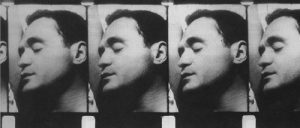
Andy Warhol – Sleep (1963)
Giuliana Bruno’s essay, “Architects of Time: Reel Images from Warhol To Tsai Ming-Liang” brings the audience back to rethinking the meaning of time. She uses examples of famous American artist Andy Warhol’s “Haircut”, “Empire”, “Kiss” to explain the concept of “zero degree” films. These films recorded the mundane acts of normal people, they were not actors, not scripted and there were no settings. They show basic emotions of how people use their time which makes the audience rethink how “films are just a way of taking up time” (Warhol, Architects of Time, p. 86.). She uses Taiwanese filmmaker Tsai Ming-Liang’s “What Time Is It There?” to convey the concept of “passing time”. She explains the idea on how time constructs space. “Witnesses, we are made to exist in the space” c indicates that we, the audience are all submerged in the mental space that the movie creates. She analyzes both artists to illustrate the theory that architecture itself is a matter of time.
From Bruno’s point of view, she leads us to reexamine “time”. She implies that time can become an atmosphere, time can shape history, and time can build up a space. She draws our attention to how time speaks a story. Taking Warhol’s “Sleep” as an example. The film engaged six hours of action and explored the atmospheric time of sleeping. The private and authentic time of the character was revealed undisguisedly. It is a cinematic reflection on daily life, which encourages audiences to reflect on how reality matters to them. The connection between the film and the audience is that everyone takes up the same time doing the same thing. The long film creates resonation between the film and the audience, making the audience more aware of the time within and out of the movie.
Through various of examples brought by Bruno, she helps audiences to understand and reevaluate the meaning of time. She pushes forward the “filmic movement” of “broadening, expanding, fragmenting, layering, exploring, rethinking time” (Warhol, Architects of Time, p. 87.). As consumers of movies, no matter then or now, we develop a state of mind of rethinking reality, space and time.
Kwong Nim Tung 3035607924